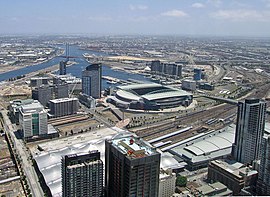Melbourne Central City Studios
|
Docklands Melbourne, Victoria |
|||||||||||||||
|---|---|---|---|---|---|---|---|---|---|---|---|---|---|---|---|

View toward Docklands from above the Melbourne CBD in 2008; from left to right - Batman's Hill and Southern Cross station, Victoria Harbour, Docklands Stadium Precinct, New Quay, Waterfront City and Digital Harbour
|
|||||||||||||||
| Coordinates | 37°49′01″S 144°56′46″E / 37.817°S 144.946°ECoordinates: 37°49′01″S 144°56′46″E / 37.817°S 144.946°E | ||||||||||||||
| Population | 10,964 (2016) | ||||||||||||||
| • Density | 3,700/km2 (9,500/sq mi) | ||||||||||||||
| Established | 2000 | ||||||||||||||
| Postcode(s) | 3008 | ||||||||||||||
| Area | 3 km2 (1.2 sq mi) | ||||||||||||||
| Location | 2 km (1 mi) from Melbourne CBD | ||||||||||||||
| LGA(s) | City of Melbourne | ||||||||||||||
| State electorate(s) | |||||||||||||||
| Federal Division(s) | |||||||||||||||
|
|||||||||||||||
Docklands (also known as Melbourne Docklands to differentiate it from London Docklands) is an inner-western suburb of Melbourne, Victoria, Australia, 2 km (1.2 mi) from Melbourne's Central Business District. Its local government area is the City of Melbourne. At the 2016 Census, Docklands had a population of 10,964. Docklands occupies an area adjacent to the Melbourne central business district (CBD), consisting of land and water totalling 200 hectares. It is bounded by Wurundjeri Way and the Charles Grimes Bridge to the east, CityLink to the west and Lorimer Street across the Yarra to the south and is a primarily waterfront area centred on the banks of the Yarra River.
Contemporary Docklands is the product of an ongoing urban renewal project to extend the area of the Melbourne CBD (excluding Southbank and St Kilda Road) by over a third when completed around 2015. It is now home to several of Melbourne's modern landmarks, including Docklands Stadium and the Melbourne Star Observation wheel.
From the 1880s, the former swamp west of Melbourne became heavily used as a dock, with an extensive network of wharfs, heavy rail infrastructure and light industry. However, following the containerisation of shipping traffic it fell into disuse and by the 1990s was virtually abandoned, becoming notable for an underground rave dance scene, a dance culture which survives through popular organised events held at Docklands Stadium.
...
Wikipedia

